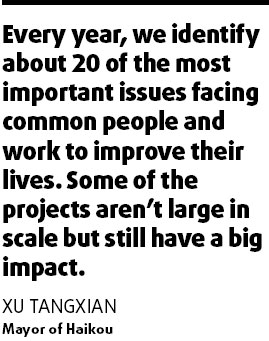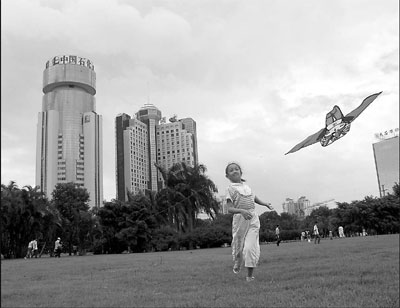Tides of change
Haikou's mayor Xu Tangxian says it's the little guys who are benefiting most from the big business that has come with the city's industrialization.
Throngs of young farmers are flocking to the urban areas of China's youngest provincial capital for jobs. And now, Xu says, these migrant workers and those they leave behind are enjoying new social programs funded by the city's growing prosperity.
|
A girl flies a kite in a Haikou park. Gao Lin |
"Industrialization has helped to bridge the gap between Haikou's rural and urban areas," he says.
Before 1988, Haikou was a 236-sq-km frontier town of 327,200 residents with a GDP of 1.182 billion yuan ($169 million). The city then had a fixed asset investment (FAI) of 482 million yuan and 105 million yuan in financial revenue.
But powerful tides of change have washed over this once-tiny coastal town, transforming it into an industrial dynamo of a city that has become the nerve center of China's largest experimental economic zone - Hainan island. Hainan was the poorest part of Guangdong province until the central government 20 years ago made it its own province to create a laboratory for experimental economic reform.
Today, Haikou is a 2,304-sq-km city of about 1.8 million residents. In 2007, it had a GDP of 39.64 billion yuan - 32.2 percent of the provincial total - FAI worth 18.3 billion yuan and its total financial revenue equaled 8.25 billion yuan.
Five major industries now propel the momentum of the city's industrialization. Its automobile industry is driven by Mazda FAW Haima Motor Co, and its garment plants generate 700 million to 800 million yuan in industrial value. The city has also become known for electronics, and Xu is proud that locally produced lighting systems have been installed in the United Nations headquarters.
In addition, Samsung Electronics Hainan Fiberoptics Co, Ltd constructed a plant in the city in 2004, and the pharmaceutical industry is also doing a healthy business in the island's capital, where it has 90 plants.
"The wealth from our industrial development provides financial support for local development, especially for improving local people's quality of life," Xu says.
Today, the central government officially recognizes Haikou as the province's leading city in providing social services. Former vice-premier Wu Yi had called upon Haikou's government to ensure at least 80 percent of its residents were covered by social services, but Xu says the coverage rate is now 95 percent.
"Almost all of Hainan's postsecondary institutions and big hospitals are concentrated here in Haikou. This and the wealth of social services we provide are why more than half of the apartments in the city were bought by people from outside the province," Xu says.
"Every year, we identify about 20 of the most important issues facing common people and work to improve their lives. Some of the projects aren't large in scale but still have a big impact."
He offers subsidized legal services for poor farmers as an example.
"If farmers don't have enough money to bring their issues to court, the government will pay their way."
He adds that improvements have also been made in education. Some parents in Haikou couldn't afford to send their children to school until government programs ensured every child could claim the right to education. "Even the costs of textbooks are covered by government subsidies, so the only expense fully paid by parents is the cost of food," Xu says.
One of the biggest projects has been improving transportation on the island, where tropical conditions have meant often-impassably muddy roads have been an historical problem. To do this, the city government has been paving highways while distributing roadmaps to residents. Also, the east circular railway, which would cut traveling time between Haikou and Sanya from three-and-a-half hours to 80 minutes, complements this local effort.
"Highways tremendously benefit the common people," Xu says. "It has greatly boosted agriculture, because villagers found it difficult to bring products to market, but after the building of the highways, they found it much easier."
Another historical problem for Haikou has been water distribution. The porous volcanic bedrock beneath the ground of much of the surrounding area makes it difficult for water to accumulate above ground. Most of the area's water tables are very low.

"It's not economical to extend our piping systems from the city to rural areas," Xu says. So instead, the government launched a project to construct 1 million wells, with the only direct cost for villagers being the piping to their homes.
Healthcare remains one of the biggest challenges for the city, Xu says. So last year, the government launched a program to assist low-income residents with medical costs.
"The government provides some of the money through subsidies, and farmers give some themselves," he explains. "Minor illnesses aren't a problem, and for major illnesses, there is a cooperative system from which farmers can get assistance."
In addition, the government has been constructing affordable housing for low-income residents. It has already provided several hundred such homes, including 700 given to families at no cost, Xu says, adding that 3,000 more such apartments would be built this year.
After the 17th CPC National Congress last fall, Haikou's leadership pledged the city would become Hainan's first city to realize a "comprehensively well-off society", as well as China's most "beautiful and delicate provincial capital".
(China Daily 04/10/2008 page18)















